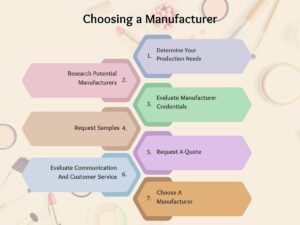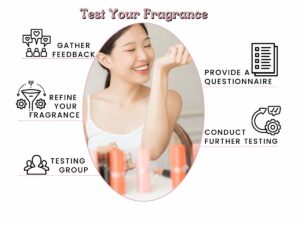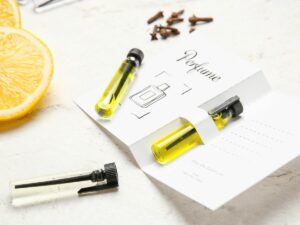Do you enjoy making perfume? Are you an aspiring perfumer in the making? If you enjoy making perfume, this could be an excellent opportunity to turn your hobby into a business.
Creating your own perfume brand can be a fulfilling and rewarding experience. Now there are many steps to take when starting your own perfume line. In this guide, we’ll walk you through the 10 easy steps to creating your own perfume brand
Read on and get ready to take notes with your pen and paper to make your business dream a reality.
1. Conduct Market Research
Market research will help you understand the fragrance industry, identify gaps in the market, and determine what types of fragrances are currently popular. The perfume market size is predicted to reach USD 50.85 billion by 2022 and is estimated to grow at a CAGR of 5.9% from 2023 to 2030. Here are some key points to when conducting market research for your perfume brand:
#1 Identify Your Target Audience
Define your ideal customer and consider factors such as age, gender, lifestyle, and buying habits. This will help you to develop a fragrance that appeals to your target audience.
#2 Analyze The Fragrance Industry
Research the fragrance industry to understand current trends and gaps in the market. I suggest that you look at consumer behavior, competitors, pricing strategies, distribution channels, and packaging designs.
#3 Determine Your Competitors
Identify your direct and indirect competitors in the market. Analyze their strengths and weaknesses, their pricing strategy, their target audience, and their marketing approach.
#4 Collect Data
Use surveys, focus groups, and social media analytics to collect data on your target audience, their fragrance preferences, and their buying habits. Here are example questions when conducting market research:
- Who is your target audience? What age group, gender, and lifestyle do they have?
- What types of fragrances are currently popular? What are the trending fragrance notes?
- What types of fragrances are missing on the market? What needs or desires are not being met by existing fragrance brands?
- What are the pricing strategies of existing fragrance brands? What price range is the most common for fragrances?
- What are the distribution channels of existing fragrance brands? Are they selling through brick-and-mortar stores, online, or through partnerships with other retailers?
- What are the packaging designs of existing fragrance brands? What type of packaging is most effective in attracting customers?
#5 Analyze Data
Review the data you have collected to identify patterns, trends, and gaps in the market. Use this information to refine your fragrance development and marketing strategy.

2. Define Your Brand Identity
Crafting a distinct brand identity is key to creating an attention-grabbing, powerful, and memorable brand that resonates with your intended audience. It will also help you to develop effective marketing strategies that effectively communicate your brand values and personality to your audience. Here are some steps that I recommend when defining your brand identity:
#1 Determine Your Brand Values
What values do you want your brand to represent? Consider factors such as quality, sustainability, luxury, or innovation. Determining your brand values is the process of identifying and defining the core principles, beliefs, and characteristics that your perfume brand stands for.
#2 Develop Your Brand Personality
Developing your brand personality involves creating a set of human characteristics and qualities that your perfume brand exhibits in its messaging, communication, and overall brand identity. Your brand personality should align with your brand values and resonate with your target audience. For example, it includes elements such as being sophisticated, adventurous, edgy, or playful.
#3 Choose A Brand Name
Choosing a strong and unique brand name, you can differentiate your perfume brand from competitors and create a memorable and recognizable brand identity. It’s important to take your time and conduct research to ensure that your brand name aligns with your brand values and personality and resonates with your target audience. Here are some tips for choosing a brand name:
- Brainstorm: Brainstorm potential brand names that align with your brand values and personality. Consider elements such as fragrance notes, target audience, and industry trends.
- Check availability: Check the availability of the name by searching for it on the internet, social media, and trademark databases. You want to make sure that the name is not already in use or trademarked.
- Test the name: Test the name with your target audience to see if it resonates with them and it is easy to remember and pronounce.
- Get feedback: Get feedback on the name from friends, family, and industry professionals to get an outside perspective and ensure that the name is a good fit for your brand.
- Make a final decision: Once you have narrowed down your options and obtained feedback, make a final decision on your brand name.
#4 Develop A Brand Story
Develop a brand story that communicates your brand values and personality to your target audience. This story should be authentic and resonate with your audience.
#5 Design Your Brand Identity
Create a visual identity that reflects your brand personality and values. This includes designing a logo, selecting colors, and choosing typography. Your visual identity should be consistent across all marketing materials.

#6 Define Your Brand Voice
Determine the tone and style of your brand communication. This includes social media, advertising, and public relations. Your brand voice should align with your brand personality and values.

3. Choose A Manufacturer
When choosing a reliable and experienced manufacturer, you can ensure that your fragrance is produced to high standards and meets the needs and expectations of your target audience. To ensure that you are making the best choice for your brand, I suggest taking your time and carefully evaluate potential manufacturers. Here are some steps to follow when choosing a manufacturer:
#1 Determine Your Production Needs
Before selecting a manufacturer, determine the volume of production you require, as well as any specific requirements for your fragrance, such as organic or vegan ingredients. Determining your production needs, you can ensure that your perfume brand can meet demand and produce high-quality products consistently. Check out these tips on how to determine your production needs:
- Determine your production volume: Determine how much perfume you want to produce and how often. This will help you to identify the equipment and production space you need.
- Identify your equipment needs: Identify the equipment you need to produce your fragrance, such as distillation equipment, mixing tanks, and bottling machines. Make sure the equipment meets the quality and production standards that you require.
- Determine your production space: Determine the size of the production space you need to accommodate your equipment and personnel. Consider factors such as ventilation, temperature control, and safety standards.
- Identify your personnel needs: Identify the number of personnel you need to produce your fragrance and package your products. Make sure that your personnel have the necessary skills and experience to ensure high-quality production.
- Develop a production schedule: Develop a production schedule that ensures your fragrance is produced and packaged efficiently and consistently. Make sure to leave enough time for quality control checks and any necessary adjustments.
- Establish quality control measures: Establish quality control measures to ensure that your fragrance meets your quality standards and is consistent in every batch. This can include sensory evaluation, chemical analysis, and packaging checks.
#2 Research Potential Manufacturers
Research potential manufacturers by looking for fragrance manufacturers that specialize in your desired production needs. You can use online directories, trade shows, and industry contacts to find potential manufacturers.
#3 Evaluate Manufacturer Credentials
Evaluate the manufacturer’s credentials by looking at their years of experience, production capabilities, certifications, and reputation in the industry. Different locations require different manufacture certifications. Here are some examples of popular certifications:
- Good Manufacturing Practices (GMP) – Good Manufacturing Practices (GMP) is a quality management system that ensures consistent production and control of products according to specified quality standards, to minimize risks in pharmaceutical production that cannot be eliminated through final product testing.
- ISO 9001 – Organizations certified to ISO 9001 have demonstrated their ability to consistently provide products and services that meet customer and regulatory requirements.
- Hazard Analysis and Critical Control Points (HACCP) – HACCP is a systematic preventive approach to food safety that identifies biological, chemical, and physical hazards in manufacturing processes. Which can lead to unsafe finished products and design measures to reduce these risks to a safe level.
#4 Request Samples
Request samples of fragrances that the manufacturer has created to determine their quality and whether they align with your brand values. Samples can help you to evaluate the quality and fragrance of the product before placing a large order
#5 Request A Quote
Once you have narrowed down your list of potential manufacturers, request a quote from each one. This will help you to compare pricing and determine which manufacturer offers the best value for your budget.
#6 Evaluate Communication And Customer Service
Evaluate the communication and customer service of each manufacturer by assessing their response time, availability, and willingness to answer your questions. Good communication and customer service are essential for building a strong relationship with customers, addressing their concerns, and ensuring that they have a positive experience with your brand.
#7 Choose A Manufacturer
Once you have evaluated potential manufacturers based on the above factors, choose a manufacturer that aligns with your brand values, production needs, and budget. The right manufacturer can ensure that your fragrance is produced consistently, meets quality standards, and is delivered on time.
By following these steps, you will be able to select the best manufacturer for your needs. If you need help deciding on a manufacturer, Nako Cosmetics can help.

4. Develop Your Fragrance
Developing a unique and high-quality fragrance, you can differentiate your perfume brand from competitors and create a product that appeals to your target audience. It’s important to take your time and work with a perfumer to ensure that your fragrance meets your specific requirements and aligns with your brand values. Here are some helpful steps that I could recommend in creating your own fragrance:
#1 Determine Your Target Audience
Before developing your fragrance, determine your target audience and what types of fragrances they prefer. Consider factors such as age, gender, lifestyle, and buying habits.
#2 Research Fragrance Notes
Research fragrance notes and how they interact with one another. This will help you to develop a unique fragrance that stands out on the market. Here are some examples of common fragrance notes that can also combine:
- Floral: Rose, jasmine, lily of the valley, lavender, ylang-ylang, magnolia, freesia, peony, and iris.
- Citrus: Lemon, lime, grapefruit, orange, and bergamot.
- Woody: Cedar, sandalwood, oakmoss, patchouli, and vetiver.
- Spicy: Cinnamon, clove, nutmeg, and black pepper.
- Fruity: Apple, peach, strawberry, raspberry, pear, and blackcurrant.
- Green: Grass, green leaves, and herbs like basil and mint.
- Aquatic: Sea salt, ocean breeze, and water lily.
- Oriental: Vanilla, amber, musk, and incense.
Here’s a video on in-depth explanation about fragrance notes:
#3 Create A Fragrance Brief
Develop a fragrance brief that outlines your desired scent profile, including the fragrance family, top notes, heart notes, and base notes. The purpose of a fragrance brief is to communicate your vision for the perfume to the manufacturer, so they can create a fragrance that aligns with your brand values, target audience, and product goals.
#4 Work With A Perfumer
Consider working with a perfumer who can help you to develop a fragrance that meets your specific requirements. A perfumer has the expertise to blend fragrance notes and create a scent that is unique and high-quality.

5. Test Your Fragrance
Testing your fragrance with a representative group of people, you can gain valuable feedback that helps to refine your scent and ensure its success in the market. Take your time and conduct blind testing to ensure that the feedback is unbiased and reliable. Here are some steps to follow when testing your fragrance:
#1 Define Your Testing Group
Define a testing group that represents your target audience. This can include people with similar demographics, lifestyles, and fragrance preferences. Here are some examples of a testing group:
- Focus group: A focus group is a small group of individuals who are brought together to provide feedback on the fragrance. This group can be made up of individuals from your target audience or other individuals who can provide valuable insights into the fragrance’s appeal.
- Blind testing group: A blind testing group is a group of individuals who evaluate the fragrance without any knowledge of the brand or other information about the product. This group can provide objective feedback on the fragrance’s scent and appeal.
- Expert panel: An expert panel is a group of fragrance experts who can provide professional feedback on the fragrance’s scent profile and appeal. This group can provide valuable insights into the technical aspects of the fragrance, as well as its market appeal.
- In-house testing group: An in-house testing group is a group of individuals within your company who can evaluate the fragrance and provide feedback. This group can include employees from different departments or individuals who represent your target audience.
- Consumer testing group: A consumer testing group is a group of individuals from your target audience who evaluate the fragrance and provide feedback. This group can be made up of individuals who are representative of your target audience, such as age, gender, lifestyle, and preferences.
#2 Provide A Questionnaire
Provide a questionnaire that asks participants to rate the fragrance on factors such as overall appeal, strength, longevity, and uniqueness. You can also ask for feedback on the fragrance notes, packaging, and branding.
#3 Gather Feedback
Gather feedback from participants and use it to refine your fragrance, packaging, and branding. This feedback can provide valuable insights into what your target audience likes and dislikes about your fragrance.
#4 Refine Your Fragrance
After group testing and the gathering of feedback, this can help you make certain adjustments that need to be made to the fragrance to meet the preferences Refining your fragrance can take time, but it is an essential step in creating a perfume brand that is well-received by your target audience.
#5 Conduct Further Testing
Once you have refined your fragrance, conduct further testing to ensure that it is well-received by your target audience. This can involve testing the fragrance with a larger group of people or testing it in different regions or markets.

6. Design And Produce Your Packaging
Designing and producing your packaging is an important step in creating a perfume brand that stands out on the market. Your packaging should be eye-catching, memorable, and align with your brand values and personality. Here are some steps to follow when designing and producing your packaging:
#1 Determine Your Packaging Needs
Determine the packaging materials and design that best represent your brand and appeals to your target audience. Consider factors such as the shape of the bottle, the color of the packaging, and any additional design elements.
#2 Develop Your Packaging Design
Develop a packaging design that aligns with your brand values and personality. This can include designing a label or selecting a unique bottle shape. Make sure that your packaging design is consistent with your visual identity and branding strategy.
#3 Create Prototypes
Create prototypes of your packaging design to ensure that it meets your requirements and looks visually appealing. This will also help you to make any necessary adjustments before producing a large batch of packaging.
#4 Choose A Packaging Supplier
Choose a packaging supplier that meets your production needs and budget. This supplier should have experience in producing packaging for the fragrance industry.
#5 Produce Your Packaging
Once you have finalized your packaging design and selected a supplier, produce your packaging in large quantities. Make sure to conduct quality control checks to ensure that the packaging meets your standards.
#6 Label Your Packaging
Label your packaging with your brand name, fragrance name, and any additional information such as the fragrance notes and volume.
By designing and producing high-quality packaging, you can differentiate your perfume brand from competitors and create a memorable product that appeals to your target audience. It’s important to take your time and carefully select a packaging supplier that meets your production needs and budget. If you need help labeling your package, Nako Cosmetics is here to help.

7. Obtain Necessary Licenses And Permits
Obtaining necessary licenses and permits is a critical step in creating a perfume brand that complies with regulations and operates legally. It’s important to research the specific licenses and permits required for your location and type of business and obtain them before starting operations. Failure to obtain necessary licenses and permits can result in fines, legal issues, and damage to your brand reputation. Here are some common ones to consider:
#1 Business License
Obtain a business license from your local government. This license allows you to legally operate your perfume brand within the area.
#2 Tax Permits
Obtain tax permits from your local and state government. These permits allow you to collect and remit sales tax on your perfume sales.
#3 Import/Export Permits
If you plan to import or export your perfume products, you may need to obtain import/export permits from the relevant government agencies. These permits are issued by government agencies and are required to ensure that the products being imported or exported meet certain standards and comply with relevant regulations.
#4 Environmental Permits
If your perfume manufacturing process produces waste or uses hazardous materials, you may need to obtain environmental permits to ensure that your business operates in an environmentally responsible manner. This can help to ensure the long-term sustainability of the business, enhance its reputation, and contribute to a healthier planet.
#5 Trademark Registration
The purpose of trademark registration is to establish exclusive rights to the use of the trademark and prevent other businesses from using similar branding elements that could cause confusion for consumers. Here are some key points to consider about trademark registration:
- Eligibility: To be eligible for trademark registration, the branding element must be unique and not in use by any other business in the same or related industry.
- Registration process: The process of registering a trademark involves filing an application with the appropriate government agency and providing evidence of use and distinctiveness. The registration process may take several months or even years to complete.
- Benefits of registration: Trademark registration provides several benefits, including legal protection against infringement, the ability to use the ® symbol, and the ability to take legal action against infringing parties.
- International registration: If the perfume brand is being marketed internationally, it may be necessary to obtain trademark registration in other countries where the brand is being sold.
- Renewal: Trademark registration must be renewed periodically to maintain legal protection.

8. Set Up A Sales And Distribution Network
You can reach a larger audience and generate revenue for your perfume brand by establishing a sales and distribution network. It is critical to take your time and build relationships with retailers who share your target audience and brand values. Here are some steps to take when establishing a sales and distribution network:
#1 Determine Your Sales Strategy
Determine your sales strategy based on your target audience and the nature of your perfume brand. Consider factors such as direct sales, online sales, and third-party retailers.
#2 Develop A Pricing Strategy
Develop a pricing strategy that aligns with your brand values and personality and is competitive with other perfume brands in the market. There are several common pricing strategies that perfume brands can use to price their products. Here are some examples:
-
Cost-plus pricing: This strategy involves adding a markup to the cost of production to determine the selling price. This markup can vary depending on the desired profit margin, competition, and other factors.
-
Value-based pricing: This strategy involves setting the price based on the perceived value of the product to the customer. This value can be influenced by the product’s quality, branding, and other factors that differentiate it from competing products.
-
Penetration pricing: This strategy involves setting a low price for a new product to gain market share and attract customers. Once the product gains traction, the price may be raised to increase profitability.
-
Skimming pricing: This strategy involves setting a high price for a new product to generate maximum profit from early adopters and customers who are willing to pay a premium for the product. The price may be lowered over time as the product becomes more widely adopted.
-
Dynamic pricing: This strategy involves adjusting the price of the product in response to changes in demand, competition, or other market factors. This can help to optimize profitability and maximize revenue.
#3 Develop Relationships With Retailers
Develop relationships with retailers that align with your target audience and brand values. Consider factors such as their location, target audience, and reputation.
#4 Create A Distribution Plan
Create a distribution plan that ensures your fragrance is available in the right locations and reaches your target audience. Consider factors such as shipping logistics and packaging requirements.
#5 Establish An Online Presence
Establish an online presence through social media, an e-commerce website, and other digital marketing channels. This will help you to reach a wider audience and make it easier for customers to purchase your fragrance.
#6 Offer Samples And Testers
Offer samples and testers to potential customers to encourage them to try your fragrance and generate interest in your brand. Offering samples and testers perfume brands can provide a risk-free opportunity for customers to try their fragrances and increase customer engagement, brand awareness, sales, and trust.

9. Launch Your Perfume
Launching your perfume is an exciting step in creating a perfume brand and sharing your fragrance with the world. It’s important to have a clear launch plan that outlines your goals and activities, as well as marketing materials that communicate your brand message and launch activities. Here are some steps to follow when launching your perfume:
#1 Create A Launch Plan
Develop a launch plan that outlines your goals, target audience, marketing strategy, and launch activities. This plan should include a timeline and budget. Additionally, create a launch plan that effectively introduces your perfume brand to the market and drives initial sales and awareness.
#2 Plan A Launch Event
Plan a launch event that generates excitement and buzz around your fragrance. This can be a public event or a private event for industry professionals and influencers.
#3 Develop Marketing Materials
Develop marketing materials such as press releases, social media posts, and advertising campaigns that communicate your brand message and launch activities. When you develop marketing materials, make sure that you can effectively communicate your brand message and product benefits, and engage your target audience.
To help you create marketing materials that effectively communicate your brand message and engage your target audience, we have created a table below. It provides key components to consider when developing press releases, social media posts, and advertising campaigns, along with examples. Use this table as a guide to ensure your marketing materials communicate your brand message and product benefits effectively.
| Marketing Material |
Description |
Purpose |
Target Audience |
Budget |
| Press Release |
A written announcement about the brand launch, including information about the brand story, product features, and availability. |
To create buzz and generate media coverage |
Journalists, bloggers, and influencers |
$500 |
| Social Media Posts |
Posts on social media platforms such as Instagram, Facebook, and Twitter that showcase the product and brand values. |
To increase brand awareness and engage with potential customers |
Consumers interested in fragrance and beauty |
$1000 |
| Advertising Campaign |
Paid ads placed on relevant platforms such as Google Ads, Facebook Ads, or influencer sponsorships. |
To reach a wider audience and drive traffic to the brand’s website or retail locations |
Consumers interested in fragrance and beauty |
$3000 |
| Packaging Design |
The design of the perfume bottle, box, and any accompanying materials such as samples and promotional items. |
To create a visual identity that reflects the brand and appeals to the target audience |
Consumers interested in fragrance and beauty |
$2000 |
| Event or Launch Party |
A launch event or party to showcase the brand and product to potential customers, influencers, and media. |
To create excitement around the brand launch and generate press coverage |
Influencers, media, and potential customers |
$5000 |
#4 Reach Out To Influencers
Reach out to influencers and industry professionals who can help promote your fragrance and generate interest in your brand. Here are some key steps to consider when reaching out to influencers:
- Identify relevant influencers: Research and identify influencers who have a following that aligns with your target audience and are interested in perfume or beauty products.
- Engage with influencers: Build a relationship with influencers by engaging with their content, commenting on their posts, and sharing their content.
- Determine collaboration opportunities: Explore different collaboration opportunities with influencers, such as product reviews, sponsored posts, giveaways, or events.
- Offer unique value: Offer unique value to the influencers, such as exclusive content, access to new products, or an opportunity to earn commissions on sales.
- Set clear goals and expectations: Set clear goals and expectations for collaboration, including the scope of the work, timeline, compensation, and deliverables.
- Track results: Monitor the performance of the collaboration, track the influencer’s impact on engagement, reach, and sales, and adjust the strategy as necessary.
- Maintain ongoing relationships: Maintain ongoing relationships with influencers, provide regular updates on new products or promotions, and continue to collaborate on new opportunities.
#5 Offer Promotions
Offering promotions is a popular marketing strategy used by perfume brands to incentivize purchases and encourage customer loyalty. Offer promotions such as discounts, giveaways, or limited-time offers to encourage customers to try your fragrance and make a purchase.
10. Continue To Innovate And Evolve
Continuing to innovate and evolve can create a successful perfume brand that stays relevant and competitive in the market. It’s important to stay up-to-date on industry trends and emerging consumer preferences, and conduct research and development to create new fragrances and products that meet the needs of your target audience Here are some steps to follow when innovating and evolving your perfume brand:
#1 Monitor Industry Trends
Monitor industry trends and emerging consumer preferences to stay up-to-date on the latest developments in the market. By monitoring industry trends, perfume brands can stay competitive, identify new opportunities for growth, and adapt to changing market conditions.
#2 Conduct Research And Development
To conduct research and development for a perfume brand, the brand needs to have a deep understanding of their target audience and their preferences. Through conducting research and development, perfume brands can continuously improve their products, develop new fragrances that meet customer needs and preferences, and stay ahead of the competition.
#3 Refine Your Marketing Strategy
Refine your marketing strategy to stay relevant and appeal to your target audience. This can include using new marketing channels, social media platforms, and advertising techniques. Here are some examples of marketing strategies that perfume brands can use to promote their products and reach their target audience:
- Influencer marketing: Collaborate with popular social media influencers and bloggers to promote the brand and its products to their followers.
- Product sampling: Offer free samples or testers to potential customers to encourage them to try the product and potentially make a purchase.
- Social media marketing: Utilize social media platforms, such as Instagram, Facebook, and Twitter, to share content, engage with customers, and promote the brand and its products.
- Email marketing: Use email marketing to reach out to existing customers, share news about new products, and offer exclusive promotions and discounts.
- Content marketing: Create engaging and informative content, such as blog posts, videos, and infographics, to educate customers about the brand and its products, and showcase the brand’s values and mission.
#4 Listen To Customer Feedback
Listen to customer feedback to determine what they like and dislike about your fragrance and packaging. Use this feedback to make any necessary adjustments and improvements.

Dive Deeper Into Our Resources
Looking for more diverse product options? Browse through our handpicked selections:
Still haven’t found what you’re looking for? Don’t hesitate to contact us. We’re available around the clock to assist you.
11. Conclusion
Creating your own perfume brand can be a fulfilling and rewarding experience. By following these 10 steps, you can develop a unique and high-quality fragrance, design eye-catching packaging, and launch your perfume brand to the market
In creating your own perfume brand, it’s important to conduct research, testing, and obtain feedback from your target audience to ensure that your brand aligns with their preferences and values. In case you require any assistance during the process, do not hesitate to seek professional guidance and support from experts, contact us at Nako Cosmetic.









